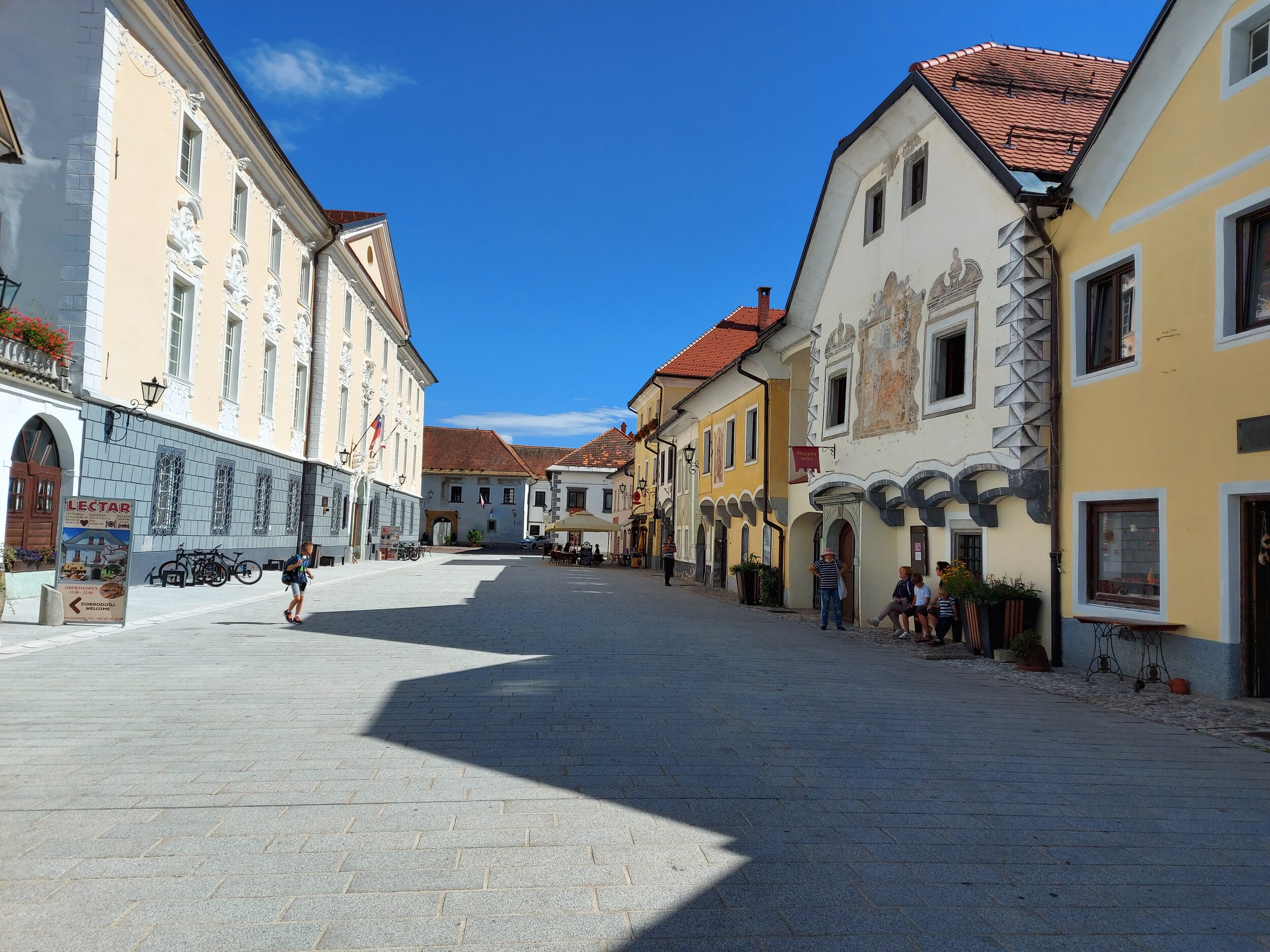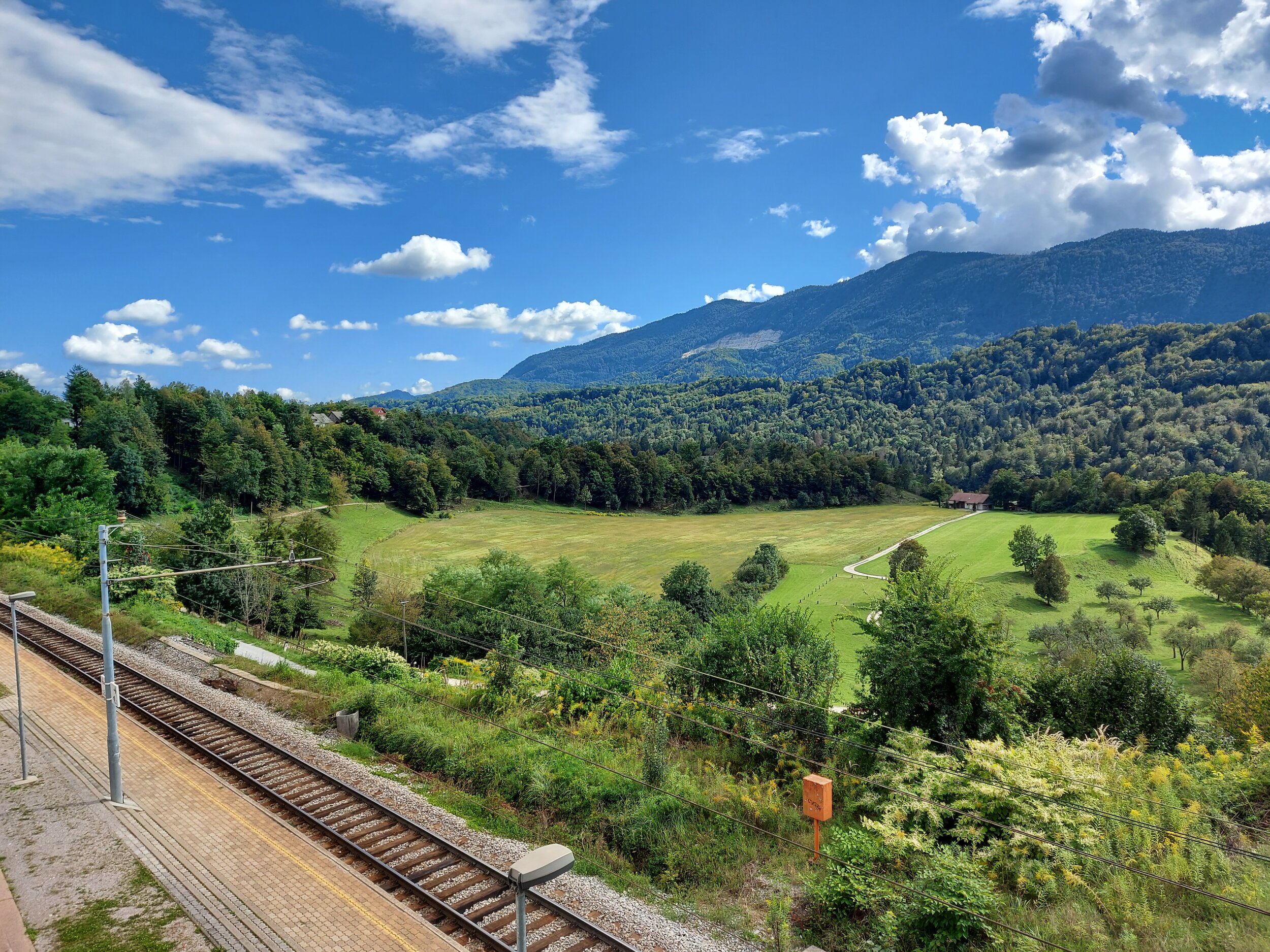32: Radovljica // Everything I Love About Slovenia, You’ll Find Here
Colourful houses in the centre of Radovljica // © Jonas Tufvesson / shutterstock
After busying myself with the rigamarole of a delicious mixed grill eaten in front of a view that is usually saved for dreaming of last meals, I forced open the heavy door guarding the standout building on Linhartov trg, the gorgeous Radovljica Mansion, built on a site that once housed a 15th-century castle built by the Counts of Orenburg but now home to offices, museums and gorgeous Baroque flourishes. Oh, and bee hives.
The mansion shimmered light from the outside but was curiously dark inside. I wandered up the stairs in a vague attempt to investigate further, moving in the direction of the twin museums that brought me inside in the first place. There was a woman behind the counter, radiating calm in a darkened setting, comfortable enough in her position to tell me that there had been a power cut and she was more than happy to let me explore the museums for free as a result, as opposed to paying the small entrance free. I obliged, walked to the right towards a multi-room love letter to apiculture, and was almost immediately greeted by the clunky sound of power returning to a large building and fresh light from previously dormant bulbs. I returned to the counter to pay my way in, only to be told not to worry about it.
Radovljica was my favourite town in Slovenia long before the free museum ticket. There, I said it. It has everything that I could possibly want, from its aesthetics down to that name, a moniker that rolls off the tongue like an old friend, curling towards the end like the final flourish of a career painting. The history too, the town has a delightful history, birthing one of the most important Slovenes of them all, all while expressing a deeper appreciation than most for chocolate and bees. Radovljica is a town built from the dreams of overly-hopeful people, a children’s television show come to life.
That isn’t too difficult to imagine, especially when stood at either end of the main square in town. I say ‘main square’, of course, I pretty much mean the only street of real interest, lined with grand old buildings of a variety of colours, an energetic old people’s home with plenty of years in them yet, taking gorgeous refuge under whatever sky the big man deems suitable for the day. There are cafes and there is neglect, but every town on the planet worth a damn has cafes and neglect.
But back to the museum, where I was entering a world of apiculture. Bees, that means bees. Slovenia has a precious relationship with its bees, one that existed for centuries before the country became the first to give the local honeybee protected status, a decision that was made in 2002. European beekeeping got its start in the hearts and minds of Slovenes, and the development of apiculture on the continent traces its steps back to an 18th-century painter from Breznica called Anton Janša.
Janša was employed as a teacher of apiculture at the royal court in Vienna (his entire story can be read in An Illustrated History of Slavic Misery), and he was also largely responsible for popularising the trend of painting the panels of beehives, telling stories and gaining eyes simultaneously. The museum in Radovljica is home to more than 250 of these things, each seemingly wackier than the last, telling biblical stories of love and lust or just good old-fashioned murder. Simple stuff, you know? I considered the many stories before moving into another room, where an actual live hive of bees hid behind closed doors.
Such a busy mass of life makes for curious viewing. I don’t know how many bees made up the hive, my guess would be in the thousands, but the harmony of it all was equal parts harmonising and troubling. I say that partly in jest, although much of my thoughts while gawping moved to a world where bees had finally succeeded in enslaving humans, forcing us into such enclosed spaces where we trampled over each other in search of work and relevance. Disturbing stuff, obviously.
After watching a short video detailing the life of the humble Carniolan bee (a gentle yet forceful bee, the embodiment of insect grace and quiet confidence), I left the Museum of Apiculture and moved into the next room, ready to discover the life and times of Anton Linhart. This was a much quieter and more stripped back affair when compared with the whirlwind of the bees, but its importance should not be disregarded as a result.
Far from it, because Anton Linhart is one of the most important Slovenians in the history of, well, Slovenians. Born in this very building (back when it was a fancy mansion, not a museum), Linhart grew up to become the father of Slovenian theatre, its first comedian and a playwright who helped give credibility to the Slovene language. What’s more, it was Linhart who is considered to be the first scholar of any importance to write about the history of all Slovenes as a single unit, as a separate Slavic ethnic group within the Austrian lands. If that makes him the Father of the Slovene nation then so be it, I’m happy to allow the lazy journalistic trope.
Impressed and educated by stories of bees and storytellers alike, I still had a nugget of time left in which to explore the nearby Pharmacy Museum, although the impending arrival of my train meant that this was far shorter than I desired. Still, it was enough time to be impressed by the over-the-counter aesthetics of the 19th and 20th century, when jars of magical medicines promised comfort and pain relief in equal measure, almost always doled out by mysterious figures who may or may not have been magicians. I made a promise to return to the museum another time when my attention wasn’t diverted to the Slovenian train timetable.
The magic of Radovljica remains untainted in my mind and in my heart. Every time I have been in the town the sun has been shining, the air has been light, the fascination has been plentiful and the desire to return has increased. My favourite town in Slovenia? As the train pulled out of the train station, itself neglected in a most beautiful sort of manner, I was in no doubt.






